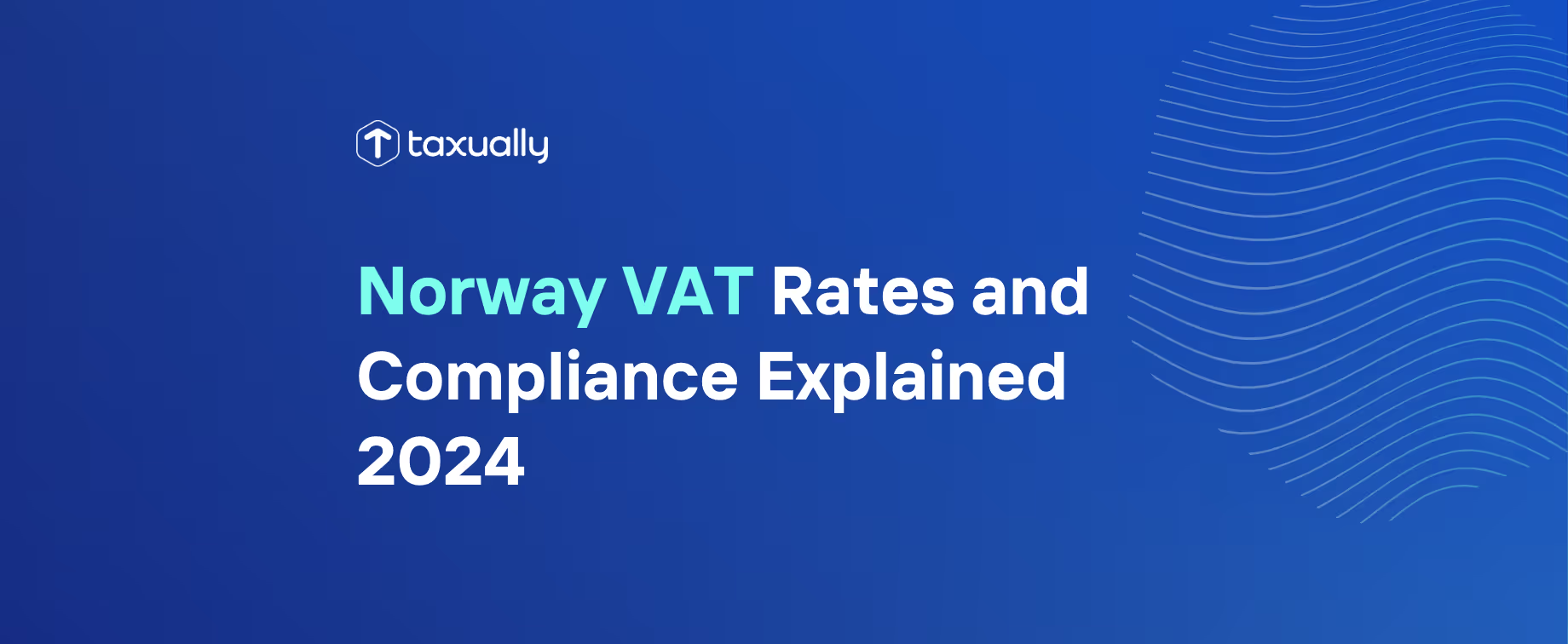Key takeaways
- Understand and comply with Norwegian VAT rates, including the standard rate of 25%, reduced rate of 15%, and low rate of 12%.
- Businesses must register for VAT when their annual turnover exceeds NOK 50,000, and ensure accurate reporting to qualify for any applicable refunds.
- Be aware of associated compliance requirements such as invoicing regulations in order to remain compliant with changing regulations and potentially receive a refund.
Understanding the various Norway VAT rates and their implications is crucial for businesses operating in Norway. With rates ranging from zero to the standard 25% rate, as well as exemptions, it’s essential to grasp the nuances to ensure compliance and avoid penalties. This guide will help you unravel the complexities of Norwegian VAT rates, registration, and compliance in 2024, providing a solid foundation for a successful business venture in this beautiful Nordic country.
Understanding Norway VAT rates
Value Added Tax (VAT) in Norway is a consumption tax levied on goods and services at different rates. The Norwegian Tax Administration is responsible for its management and collection. Businesses registered for VAT are required to charge Norwegian VAT on their goods and services, and understanding the different rates is essential to avoid non-compliance, which may result in fines and other penalties.
With a standard VAT rate of 25%, a reduced rate of 15%, a low rate of 12%, as well as various exemptions, it’s vital to know how these rates apply to your business operations.
Standard VAT rate: 25%
The standard VAT rate in Norway is 25% and applies to the majority of goods and services. This rate is applied to most transactions, such as electronics and clothing.
Reduced VAT rate: 15%
Norway offers a reduced VAT rate of 15% for specific items, such as food products, drink items, food supplements, and non-prescription medications.
Low VAT rate: 12%
In addition to the standard and reduced rates, Norway applies a low VAT rate of 12% to certain goods and services associated with tourism, culture, and transportation. This rate benefits sectors such as accommodation services, amusement parks, and sporting events.
Zero VAT rate and VAT exemptions
In Norway, healthcare, education, and financial services are some of the goods and services that are exempt from VAT. Norway also has a 0% VAT rate, which includes books, e-books, and newspapers. Businesses providing goods and services that are zero-rated or VAT-exempt must still report them on their VAT declaration form.
VAT registration and compliance

Knowing when and how to register for VAT in Norway is critical for businesses operating in the country. Here are the key steps to follow:
- Determine if your annual turnover exceeds NOK 50,000.
- If it does, you must register for VAT.
- Upon successful registration, you'll be assigned a Norwegian VAT registration number.
When to register for VAT
Businesses are required to register for VAT in Norway when their annual turnover exceeds NOK 50,000 over a twelve-month period. Be sure to differentiate between sales to Norway and sales in Norway when considering VAT registration, as different rules may apply.
Once a business becomes liable for VAT in Norway, the VAT registration process must be completed within 30 days.
Online VAT registration process
The simplified online VAT registration process in Norway allows businesses to register via the Norwegian Tax Administration’s website. The process involves completing the VAT registration application form, providing the required documentation, and submitting the application online. Upon successful registration, businesses will receive a Norwegian VAT registration number.
VAT obligations
Businesses operating in Norway must adhere to various VAT obligations, including:
- Charging the appropriate VAT rate on their goods and services.
- Reporting these transactions.
- Transferring the responsibility for accounting for VAT from the seller to the buyer when the reverse charge mechanism applies (certain B2B transactions).
For B2C transactions, online merchants must collect VAT from customers, utilizing the VOEC scheme for low-value goods. Understanding these obligations is vital for maintaining compliance and avoiding penalties.
VAT returns and reporting
Accurate and timely VAT returns and reporting are essential for businesses operating in Norway.
Filing frequency
The frequency of VAT return filing in Norway is bi-monthly for most businesses. However, businesses with an annual turnover of less than NOK 1 million can choose to file semi-annually.
The submission due date for VAT returns is one month and ten days after the reporting period, and it's crucial to meet these deadlines to avoid penalties and interest charges.
Submission process
It's mandatory to submit VAT returns electronically in Norway. This can be done easily through the Altinn portal. This platform simplifies the submission process and promotes accuracy and efficiency in reporting.
The Norwegian Tax Administration provides guidance on using the Altinn platform and adhering to the required e-invoice standards, such as the EN 16931, EHF, and Peppol BIS formats.
Sales and purchase list reporting
By 2024, it's anticipated that Norway will implement transaction-level VAT reporting, requiring businesses to report individual purchase and sales transactions. This change aims to improve the accuracy and efficiency of VAT reporting and reduce the likelihood of incorrect submissions.
Businesses must adapt to these upcoming changes and ensure their accounting systems can accommodate the new reporting requirements.
Importing and exporting goods
When importing and exporting goods in Norway, understanding the VAT implications is essential for accurate reporting and compliance. Different VAT rates apply depending on the type of goods being imported or exported, and businesses must be aware of these rates to properly account for VAT on their transactions.
VAT rates can vary significantly, so make sure to research the applicable rate for each transaction.
Import VAT
The import VAT in Norway varies based on the type of goods imported. It's usually aligned with the standard, reduced, or low rate applicable in the country. The importer is responsible for determining and settling the VAT on imported goods. Failure to do so can result in significant financial penalties and interest charges.
Export VAT
Exporting goods from Norway is typically free from VAT. This applies if the goods are dispatched from Norway to a place outside of Norway’s VAT area. To claim the zero-rate VAT, suppliers must maintain appropriate documentation as evidence of the export, such as sales contracts, transport documents, and customs declarations.
These documents should be kept for at least five years and must be made available to the Norwegian tax authorities upon request.
Cross-border services and ecommerce
The VAT rules for cross-border services and ecommerce transactions in Norway depend on the customer’s location. In some cases, Norwegian businesses may not be required to charge Norwegian VAT.
Understanding these rules is essential for businesses engaging in cross-border transactions, ensuring accurate reporting and compliance.
B2B Transactions
For B2B transactions in Norway, the reverse charge mechanism applies, transferring the responsibility for accounting for VAT from the seller to the buyer in cross-border transactions. This mechanism simplifies the VAT process for businesses, reducing the administrative burden associated with charging VAT on cross-border services.
The reverse charge mechanism eliminates the need for the seller to register for VAT in the buyer's country.
B2C Transactions
With B2C transactions, online merchants must collect VAT from customers, using the VOEC scheme to simplify the process for low-value goods. As of January 1, 2023 Norway has expanded its VAT regulations to include all “remotely deliverable services” from foreign sources to consumers in the Norwegian VAT area, increasing their VAT liability.
Non-resident providers of remotely supplied non-digital services must register and collect VAT on B2C sales, emphasizing the importance of understanding VAT rules for ecommerce transactions.
Invoicing and e-invoicing requirements

Proper invoicing and e-invoicing practices are essential for businesses operating in Norway, as they ensure accurate reporting and compliance with VAT regulations. Invoices must contain specific information, and e-invoices must adhere to certain standards, such as EN 16931, EHF, and Peppol BIS formats.
These standards are designed to ensure that e-invoices are secure, complete, and accurate.
Invoice content
Invoices issued in Norway must include the following information:
- Date of issuance
- Unique invoice number
- Supplier and customer information
- Description of the goods or services provided
- Quantity
- Price
- VAT rate
- Total amount due
Ensuring that invoices contain all the required information promotes accurate reporting and compliance with Norwegian VAT regulations.
E-invoice standards
E-invoice standards in Norway include EN 16931, EHF, and Peppol BIS formats. Public entities’ suppliers are required to send e-invoices in the European Peppol BIS Billing 3.0 format, while the EHF format is recommended for B2B and B2G invoices.
VAT refunds
VAT refunds can provide financial benefits for businesses in Norway, and understanding the VAT refund process means businesses are able to maximize such benefits.
A VAT-registered entity in Norway may be eligible for a refund of the input VAT on its own acquisitions of goods and services used in the business. The refund process typically requires a six-month period to complete, with a cut-off date for submitting the annual VAT return of January 31.
Conclusion
Businesses selling to customers in Norway must have a clear understanding of Norwegian VAT, from rates and registration to invoicing and refunds. By staying informed and compliant with these regulations, businesses can minimize the risk of fines and other penalties, ensuring a successful and profitable venture in this thriving Nordic market.
Do you need help with your VAT compliance? Book a free call with one of our VAT experts to find bespoke solutions for your business, optimize your VAT costs, and reach millions of new potential customers.
Frequently asked questions
New Year's Day - 1/1/2024Memorial Day - 5/27/20244th of July - 7/4/2024Labor Day - 9/2/2024Thanksgiving Day - 11/28/2024Day after Thanksgiving - 11/29/2024Christmas Eve - 12/24/2024Christmas Day - 12/25/2024
What is the VAT rate in Norway 2024?
The standard VAT rate in Norway in 2024 is 25%. This rate applies to most goods and services that are not covered by reduced VAT rates.
However, there are some exceptions.
Is VAT 12% in Norway?
While the standard rate for VAT in Norway is 25%, there is a low rate of 12% applied to specific goods and services.
Is Norway in the EU VAT system?
No, Norway is not part of the EU VAT system. However, it does follow most of the rules and regulations set by the EU VAT Directive.
When do businesses need to register for VAT in Norway?
Businesses in Norway are required to register for VAT if their annual turnover exceeds NOK 50,000.



















